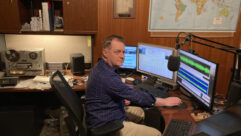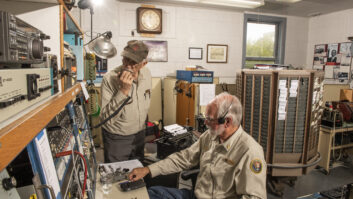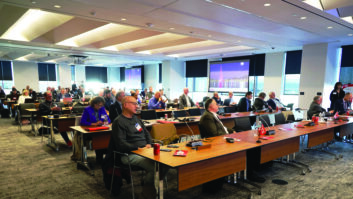(click thumbnail)Fig. 1: A nice clean interior for a transmitter shack.Grady Moates of Loud and Clean Consulting in Boston has a contract client who is king of the shipboard storage containers. I’d heard of using these steel containers for transmitter buildings, but never seen the idea implemented in such a grand way.
Langer Broadcasting Group President Alex Langer has chosen 8×20- and 8×40-foot buildings for about $3,000 new. Compare that to a concrete building running $25,000 or more.
Used containers may be less expensive, Alex says, but you never know what you’re going to get. The extra money for a “new” container is well spent, according to Alex. The new containers are painted inside, as seen in Fig.1, and the steel shielding is an added benefit, according to Grady.
At one site, three storage containers hold the main transmitter, the phasor, the auxiliary transmitter and the tower coupling network. Inter-container cabling is handled through conduits linking the buildings, seen in Fig. 2.
Fig. 3 shows panel-mounted coupling components bolted to the steel wall. At the right rear of the picture, electrical boxes and conduit are mounted to a wooden board, also bolted to the wall.
White-painted walls and corner-mounted florescent fixtures keep the building bright, helpful for maintenance and troubleshooting. The doors are double-latched, with a rubber gasket, so the inside is clean and dry.
***
John Stortz is engineering manager for the Moody Broadcasting Group in Central Florida. He writes that he was disturbed to read about the “remote relay reset assembly” in our Feb. 1 column. No wonder the inventor wanted to be anonymous, he said.
(click thumbnail)Fig. 2: Conduit is used to link storage containers.
John’s hope was that this was only installed as a temporary solution. Unfortunately, “temporary” can become “permanent” easily, especially at stations where the owner/manager counts every penny.
He suspects this engineer assumed the breaker was tripping at the proper current. Ask any electrician and they will tell you circuit breakers can fail. John was tempted to install a similar design to reset a plate breaker on a CCA transmitter. It too had the annoying habit of tripping in the middle of the night, about once every two weeks. John, also, had assumed the breaker was doing its job, but found he was wrong.
He tested the 175A, three-phase breaker and discovered the middle section would only hold 115A for about 30 seconds. The normal input current for the plate transformer was 112A per phase in the daytime. No more calls after they replaced the breaker.
In case readers are wondering how they tested a 175-amp breaker, John and his staff used 175 amps, of course. They built an adjustable high-current power supply from the “Junque Box,” which cost almost nothing.
The first item is a good chunk of iron for a transformer. They had an old plate transformer sitting around from an HT-20 transmitter with one shorted secondary. It was too heavy to move, so John had been cutting the copper off, before attempting to tear apart the iron, to reduce the weight to manageable pieces for disposal.
John’s assistant, Don Jeerings, pressed him to save the iron, with the primaries intact. This became the start for their high-current breaker tester. Now the transformer needed a low-voltage/high-current secondary. Don had about 25 feet of heavy welding cable that had fallen off some contractor’s truck, which he found laying on a highway. It became the three- to five-turn secondary, with enough extra cable to conveniently reach to the breaker.
(click thumbnail)Fig. 3: Securing copper ground strap.
One more item was needed, which was contributed from another engineer’s Junque collection – a 50A variable autotransformer, sometimes known by the brand names Variac or Powerstat. Although the autotransformer was oversized, the price was right. Probably a 10-amp autotransformer would have done just as well.
The autotransformer allowed the engineers to dial up any voltage between zero and about 130V, which was applied across the 240V primary of the old plate transformer. The secondary, connected to the breaker only, would produce any current from zero to over 300 amps, depending on the autotransformer setting. A clamp-on ammeter that they owned would read a maximum of 300A.
Dealing with 300 amps sounds dangerous, but it’s not. At the setting for 300A, the open circuit secondary voltage was about one volt, as John recalls.
After replacing the breaker, no more dropouts. Since this test, John and Don have installed casters to the old transformer to make it easier to move around.
***
Don’t whack your head on all-thread or bolts supporting cable trays or RF line inside your transmitter plant.
(click thumbnail)Fig. 4: Slip a plastic nub over that long bolt to save yourself a headache.
Flexible plastic nubs can be found at any electric supply company. Slip them over the dangerously sharp edges. The plastic protectors also keep threads clean, so if you ever need to remove or readjust the bolt, you won’t experience the frustration of knurled threads.
***
RSI, which offers RF safety training and compliance, is coming to Chicago in April, and other locations are scheduled.
RF safety is serious business; compliance to regulations is not optional. The costs of compliance are affordable to any licensee, employer or property owner. Regulations are straightforward and so are the solutions to becoming compliant.
RSI’s RF Site Safety Awareness seminar helps attendees understand FCC and OSHA policies and informs participants of radiofrequency and general safety issues. Its class is intended for people responsible for or working in RF environments.
For larger companies, the company also offers an RF “Train the Trainer” seminar, a three-day class that teaches you how to train your own employees. Participants also receive a 10-hour OSHA card.
Reserve a seat by calling RSI at (888) 830-5648 or register online at www.rsicorp.com
















